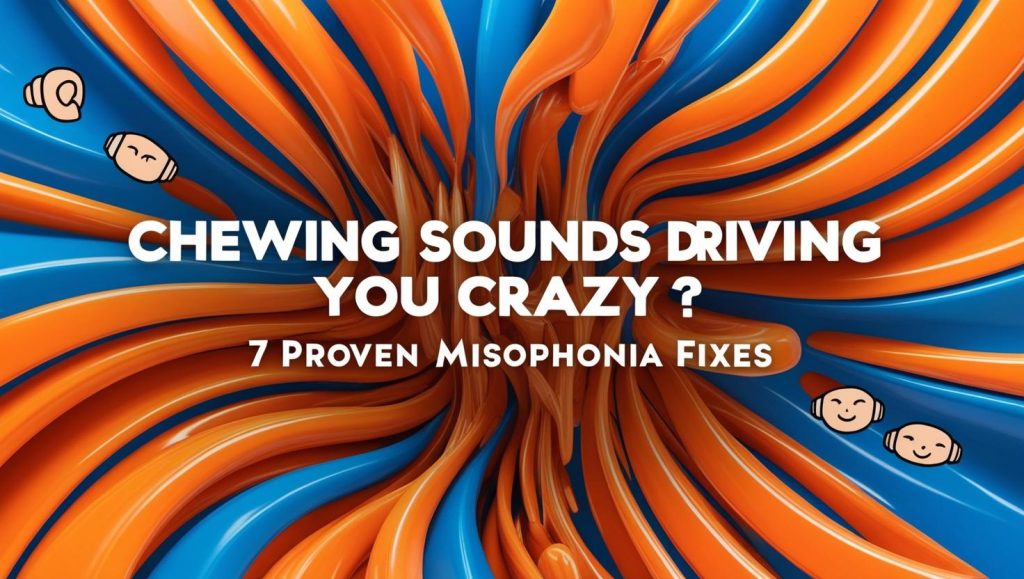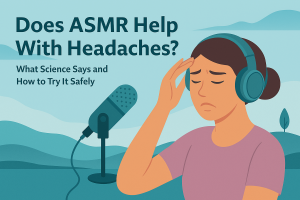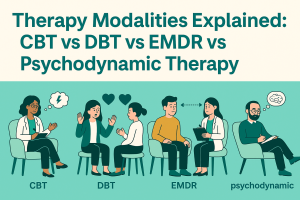You’re trying to enjoy a quiet meal—or survive your morning commute—and someone starts chewing loudly next to you. Suddenly, your blood pressure spikes.
Your jaw tightens. You feel the urge to scream, flee, or smash something. If this sounds familiar, you’re not alone. You might be dealing with misophonia—a real condition where everyday sounds trigger intense emotional reactions.
And yes, chewing sounds are often the worst culprits.
Good news? You’re not doomed to live in rage or headphones forever. There are real, research-backed strategies that can help you reclaim your calm. Let’s break down why chewing sends your brain into a tailspin—and what to do about it.
Why Chewing Sounds Trigger Misophonia
The Brain’s Reaction to “Mouth Sounds”
Misophonia literally means “hatred of sound.” But it’s more specific than just disliking noise. Your brain interprets certain repetitive or wet sounds—like chewing—as threats. This kicks your fight-or-flight system into high gear, even though you’re technically “safe.”
The worst part? You can’t just “tune it out.” The sound bypasses logic and goes straight to your emotional core.
Is This Normal or Misophonia?
Annoyed by slurping? That’s normal. Enraged by the sound of someone chewing an apple 15 feet away? That’s probably misophonia.
Misophonia isn’t about volume. It’s about patterned, human-generated sounds—especially from people close to you. The closer the person is emotionally, the worse it can hit. It’s not personal, but it feels that way.
Emotional Fallout from Everyday Noise
Over time, these repeated triggers can cause:
- Anxiety and panic
- Relationship strain
- Avoidance of meals and social situations
- Exhaustion from constant hypervigilance
This isn’t just a “quirk.” It’s a condition that deserves attention, understanding, and solutions.
Understanding the Misophonic Response
The Science Behind the Rage
Neuroimaging shows that people with misophonia have abnormal connectivity between the auditory cortex and the insular cortex—part of the brain that processes emotion and threat detection. That’s why a slurp can feel like a siren in your head.
This isn’t about being dramatic. It’s a neurological reaction your body has little control over—until you learn to manage it.
Why Chewing Is One of the Worst Triggers
Chewing sounds hit a trifecta of misophonic horror:
- Close proximity: Often happens during meals, when you’re expected to stay still.
- Repetition: The same crunch, slurp, or smack over and over again.
- Wetness: Mouth sounds involve saliva, swallowing, lip movements—all sensory red flags for misophonia.
Misophonia vs. Pet Peeves
Misophonia causes visceral, full-body reactions—not just annoyance. If chewing noises leave you sweating, enraged, or panicked, you’re not dealing with a pet peeve. You’re dealing with a brain-based sensitivity that deserves support.
7 Proven Fixes for Coping With Misophonia
1. Use Noise-Canceling Headphones Strategically
When in doubt, block it out. Headphones are a daily essential for many with misophonia. Use them:
- During meals (with discreet earbuds if needed)
- On the subway or bus
- At work, paired with ambient music
Top-rated brands include Bose, Sony, and AirPods Pro—anything with adjustable noise-cancellation and comfort.
2. Mask the Sound With Background Noise
You don’t need silence—you need control. White noise, brown noise, rain sounds, or even a fan can help mask triggers in shared spaces.
Apps like “Noisli,” “Calm,” or “myNoise” let you customize your own soothing soundtrack to drown out chewing chaos.
3. Try Cognitive Behavioral Therapy (CBT)
CBT helps you retrain your response to triggers by identifying thought patterns and replacing them with grounding strategies. It won’t erase the sound—but it can reduce your emotional response to it over time.
Look for NYC-based or virtual therapists who understand misophonia or sensory processing sensitivity.
4. Create an Exit Plan for Trigger Environments
Have an escape route. When eating with others, sit near an exit or excuse yourself to the bathroom for a quick reset. At work, request a quiet area or flexible seating when possible.
Knowing you can leave reduces the panic, even if you stay.
5. Set Boundaries With Family and Coworkers
Talk about your condition openly (but calmly). Say:
- “I have a neurological sensitivity to certain sounds. It’s called misophonia.”
- “It’s not personal, but I sometimes need space or headphones during meals.”
- “I really appreciate your understanding.”
The goal is teamwork, not blame.
6. Practice Grounding Exercises During Triggers
Try this when a sound hits you hard:
- Breathe in for 4 counts, hold for 2, out for 6.
- Touch something textured (a bracelet, jeans seam, cool glass).
- Count five things you can see, four you can touch, three you can hear…
Grounding reorients your brain away from panic and back to the present.
7. Join Misophonia Support Communities
Misophonia can feel isolating—until you realize so many others feel the same. Online forums like the Misophonia subreddit, Facebook groups, or local NYC meetups offer solidarity, humor, and practical tips.
Being understood changes everything.
How to Talk About It Without Conflict
Expressing Needs Without Blame
Start with “I” statements:
- “I’m working on managing this condition, but I still get overwhelmed.”
- “I need some space when eating, not because of you—but because of how my brain reacts.”
Calm honesty builds bridges.
Explaining Misophonia to Loved Ones
Use short, clear phrases:
- “My brain sees certain sounds as threats.”
- “It’s like a fire alarm going off in my head.”
- “It’s not your chewing—it’s how my system processes it.”
Share links, videos, or infographics that explain the condition so others can better empathize.
Advocating for Yourself in Shared Spaces
At work or school:
- Request a quiet desk
- Ask to wear earbuds during tasks
- Suggest “quiet zones” if possible
Advocacy isn’t overreacting—it’s preserving your peace.
When to Seek Professional Help
If misophonia:
- Disrupts your ability to eat with others
- Causes conflict in relationships
- Triggers panic attacks, rage, or depression
…it’s time to talk to a therapist or audiologist. Look for practitioners in NYC or online who specialize in sensory processing or sound disorders.
You’re not weak for needing support—you’re strong for seeking it.
Conclusion
If chewing sounds are driving you up the wall, you’re not broken—and you’re not alone. Misophonia is real, but so is relief. With the right tools, strategies, and support, you can move from reactive rage to calm control.
You deserve meals without misery, conversations without tension, and a brain that feels safe. Start small, stay consistent, and remember: your peace is worth protecting.
FAQs
1. What causes misophonia?
Experts believe it’s a neurological condition linked to heightened brain connectivity between sound processing and emotional centers.
2. Can misophonia go away on its own?
Not usually, but symptoms can improve significantly with therapy, lifestyle changes, and support.
3. Is there medication for misophonia?
There’s no specific medication for misophonia, but anxiety or mood stabilizers may help in some cases under professional guidance.
4. Can I train myself to tolerate trigger sounds?
Yes—desensitization therapy, CBT, and gradual exposure can reduce reactivity over time.
5. Are there NYC therapists who treat misophonia?
Yes. Look for sensory-informed therapists, CBT specialists, or clinics like Weill Cornell or NYU that offer sound sensitivity support.
More Resources:
-
Learn about misophonia triggers from the International Misophonia Research Network.
-
Cognitive-behavioral techniques for sound sensitivity at American Psychological Association.
-
How noise-canceling tech helps – Harvard Health Publishing.




